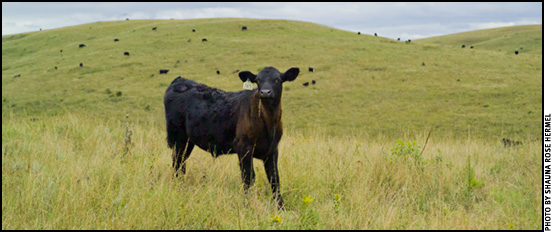
Worth the Weight
A K-State livestock economist discusses value of gain projections for feeder cattle, nationwide beef herd expansion.
The current environment for the beef industry includes a limited supply of feeder cattle and stable consumer demand for beef, said Glynn Tonsor, livestock economist for Kansas State University (K-State). The environment is driving record-high prices for cattle.
Many producers and commercial stockers are likely debating the best time to buy and sell calves. Tonsor said those who have the feed resources available should consider putting extra weight on the calves prior to selling.
“Today, someone who might have weaned a fall steer and have a 700-pounder around today will entertain selling him,” he said. “But, if you are in a situation where you still have something to feed the steer and you could put an additional 50 pounds (lb.) on him, the market is strongly encouraging you to do that.”
In this example, Tonsor pointed out that the feeder-cattle market in June compared to May looks to be higher. If the steer sells at a higher price in June when he is 50 lb. heavier, the value of gain (VOG) is projected to be more than $2, around $2.11, which could well exceed the cost of gain (COG) for producers who have access to feed resources.
For producers who will be weaning calves this fall, or commercial stockers looking to purchase weaned calves, consider this: Putting an additional 200 lb. on calves could have a VOG around $1.20. That’s comparing selling calves at 550 lb. in late September to selling them at 750 lb. in late December.
“Most people will have a COG close to a buck, or a little bit lower, so there are positive margins being projected there, as well,” Tonsor said.
Tonsor used www.beefbasis.com as a resource for figuring VOG projections. He recommends that producers visit K-State’s Ag Manager website at www.agmanager.info, where they will find links to the Beef Basis website and Livestock Marketing Information Center’s website, www.lmic.info. These resources allow cattle buyers and sellers to view market reports and compare costs.
What about herd expansion?
While many cow-calf producers are taking advantage of selling with the current high feeder-cattle prices, many are also looking to expand the herd following a few years of extensive drought. Tonsor said despite high prices, there is evidence that the industry is trying to expand by retaining heifers and not culling as many cows.
In the first quarter of 2014 on a nationwide basis, he said, there has been a notable reduction in the portion of feedlot placements represented by heifers, which indicates they are staying on a farm or ranch somewhere.
“The magnitude is in line with 2006, the last time we tried to expand the herd,” Tonsor said.
Herd expansion is also reinforced when examining slaughter data, he said. Cow slaughter is down compared to last year, but this could be partly due to fewer cows available to send to market. Steer slaughter is slightly down, depending on the week, compared to last year. Heifer slaughter is way down from a year ago.
“I think there are a lot of signals that the industry as a whole has pulled the trigger on expansion,” Tonsor said. “Time will tell how much, but we are trying to expand in aggregate nationwide. Maybe Texas, the Oklahoma Panhandle and California are not participating (due to continued drought), but expansion is occurring in other spots.”
Nationally, there is less pasture and range acreage in poor and very poor condition compared to last May, according to the USDA’s Crop Progress Report (http://usda.mannlib.cornell.edu/MannUsda/
viewDocumentInfo.do?documentID=1048). However, Tonsor said U.S. pasture and range condition is still worse today than the five-year average prior to 2013.
He added that there are fewer cows located in poor and very poor condition areas currently. Only 7% of cows in the United States are in areas reported to be poor or very poor today, compared with 52% in 2013.
“I don’t want to dismiss the fact that there are pockets in a lot worse condition, but many areas are in better condition compared to 2013,” Tonsor said. “This facilitates the national story of some heifers staying at home and producers trying to expand.”






